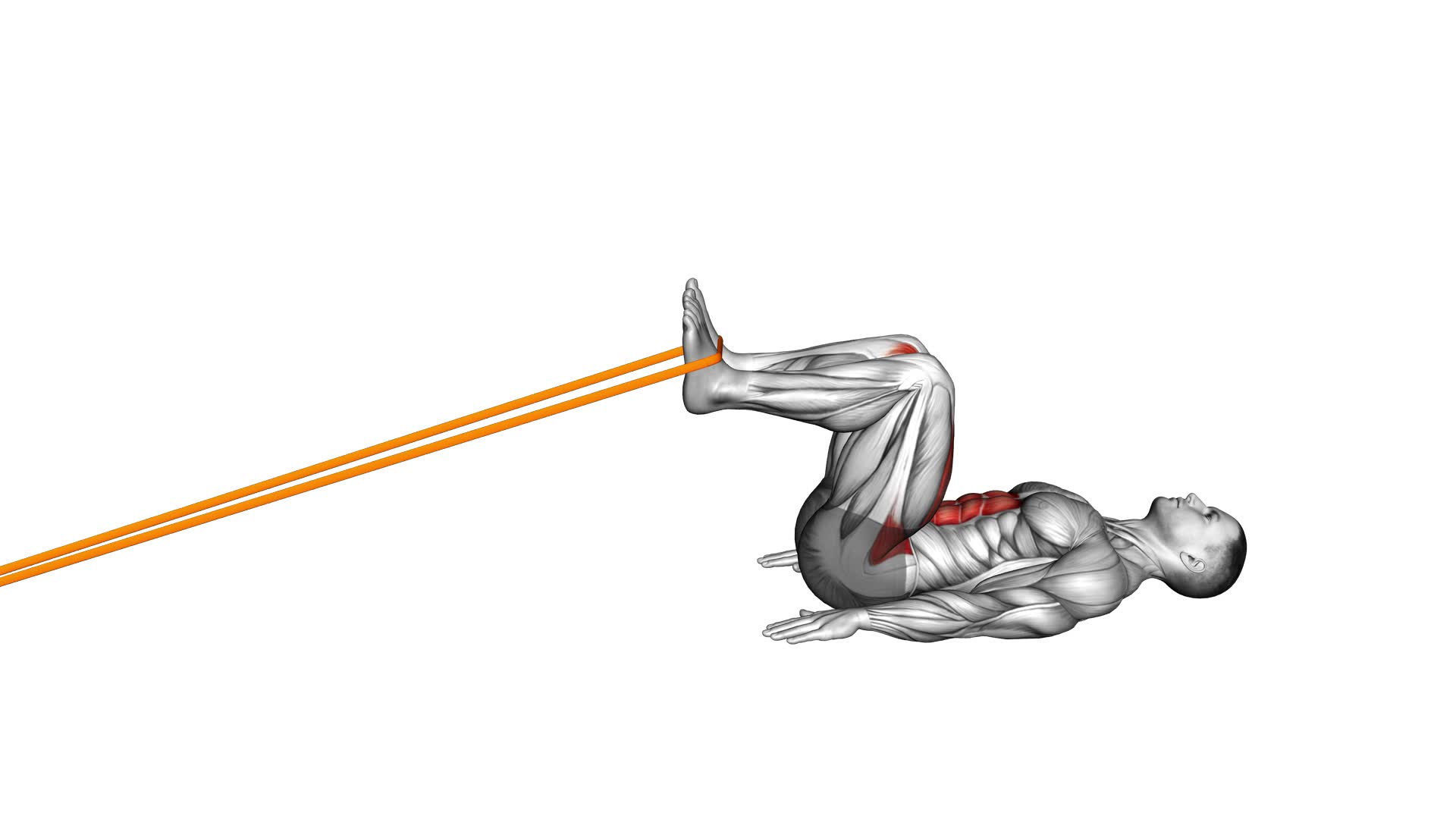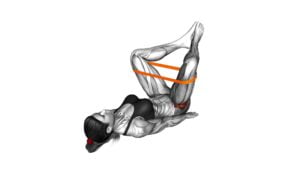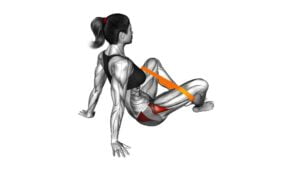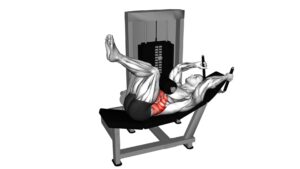Resistance Band Lying Bent Knee Raise (male) – Video Exercise Guide & Tips

Are you looking for a challenging exercise to target your lower abs? Look no further than the resistance band lying bent knee raise.
Watch This Exercise Video
This exercise is perfect for men who want to strengthen their core and improve their overall fitness.
In this article, we will guide you through the proper form and technique for this exercise, provide helpful tips, and even offer a variation to add an extra twist to your workout.
Get ready to feel the burn!
Key Takeaways
- Resistance Band Lying Bent Knee Raise targets lower abdominal muscles and strengthens and tones abs.
- It adds extra challenge and intensity to a workout, increasing core strength.
- It can be conveniently done anywhere and is a portable exercise option.
- Engaging proper form and technique, choosing the appropriate resistance band, and maintaining proper breathing are important for getting the most out of this exercise.
Benefits of Resistance Band Lying Bent Knee Raise
There are several benefits to incorporating resistance band lying bent knee raises into your workout routine. This exercise specifically targets your lower abdominal muscles, helping to strengthen and tone them. By engaging your core throughout the movement, you're able to improve your core strength as well.
One of the main advantages of resistance band lying bent knee raises is that they provide a unique and effective way to work your lower abs. The resistance band adds an extra challenge to the exercise, forcing your muscles to work harder and increasing the intensity of the workout. This can lead to faster results and a more defined abdominal area.
Additionally, resistance band lying bent knee raises are a convenient exercise that can be done anywhere. All you need is a resistance band and some floor space, making it a great option for those who prefer to workout at home or while traveling.
Incorporating resistance band lying bent knee raises into your routine can help you achieve a stronger core and target your lower abdominal muscles more effectively. So why not give them a try and start reaping the benefits today?
Proper Form and Technique for Resistance Band Lying Bent Knee Raise
To perform the resistance band lying bent knee raise with proper form and technique, focus on maintaining stability and engaging your core throughout the exercise. This will help you maximize the benefits and minimize the risk of injury.
Start by lying on your back with your legs extended and the resistance band securely looped around your feet. Bend your knees and bring them towards your chest, keeping your feet flexed. This is your starting position.
As you raise your knees towards your chest, exhale and engage your core muscles. Keep your back flat against the floor and avoid arching or rounding your lower back. This will ensure that you're targeting your abdominal muscles effectively.
A common mistake to avoid is using momentum to lift your legs. Instead, focus on using your abdominal muscles to control the movement. This will provide a greater challenge and increase the effectiveness of the exercise.
If you find the resistance band lying bent knee raise too challenging, there are alternative exercises you can try. One option is to perform the exercise without the resistance band, focusing on the same form and technique. You can also try bent knee marches, where you lift one knee at a time while keeping the other foot on the ground. This variation allows you to build strength before progressing to the full exercise.
Remember to always listen to your body and adjust the intensity as needed.
Variation: Resistance Band Lying Bent Knee Raise With Twist
To add an extra challenge and engage your oblique muscles, try the variation of the resistance band lying bent knee raise with a twist. This exercise is a great way to target your core and strengthen your muscles.
To perform this variation, start by lying on your back with your legs straight and a resistance band wrapped around your feet. Bend your knees and bring them towards your chest, then twist your knees to one side while keeping your upper body still. Return to the starting position and repeat the twist on the other side.
The twisting motion engages your oblique muscles, which are located on the sides of your abdomen. This variation not only targets your core but also adds an element of stability and balance.
By incorporating resistance band exercise variations like the lying bent knee raise with a twist, you can maximize your workout and challenge different muscle groups.
Now, let's move on to some tips for getting the most out of the resistance band lying bent knee raise.
Tips for Getting the Most Out of Resistance Band Lying Bent Knee Raise
To maximize your results with the resistance band lying bent knee raise, follow these tips. By incorporating these suggestions into your workout routine, you can ensure that you're getting the most out of this exercise.
Firstly, it's important to maintain proper form throughout the movement. Common mistakes include using momentum to swing your legs up instead of relying on your core strength. To avoid this, focus on engaging your abdominal muscles and using them to lift your legs. This will maximize the effectiveness of the exercise and target your lower abs more effectively.
Additionally, it's crucial to choose the right resistance band for your fitness level. Using a band that's too light won't provide enough resistance to challenge your muscles, while a band that's too heavy may compromise your form. Experiment with different bands to find the one that allows you to perform the exercise with proper technique while still feeling challenged.
Lastly, remember to breathe properly during the exercise. Many people tend to hold their breath when performing abdominal exercises, which can lead to increased tension in the muscles and decreased effectiveness. Take deep breaths in and out as you lift and lower your legs to ensure that you're maximizing your results.
Safety Precautions and Modifications for Resistance Band Lying Bent Knee Raise
To ensure your safety and make necessary modifications, it's important to be aware of certain precautions when performing the resistance band lying bent knee raise. Safety modifications and injury prevention should always be a priority when engaging in any exercise routine.
Firstly, it's crucial to choose the right resistance band for your fitness level. Using a band that's too strong can put excessive strain on your muscles and joints, increasing the risk of injury. Start with a lighter band and gradually increase the resistance as you become stronger and more comfortable with the exercise.
Secondly, maintain proper form throughout the exercise. Keep your back flat on the floor and engage your core muscles to stabilize your spine. Avoid arching your back or using momentum to lift your legs. This will help prevent strain on your lower back and maintain the effectiveness of the exercise.
Additionally, listen to your body and take breaks when needed. If you experience any pain or discomfort, stop immediately and consult with a healthcare professional. Pushing through pain can lead to further injury and setbacks in your fitness journey.
Lastly, always warm up before starting the exercise and cool down afterwards. This will help prepare your muscles for the movement and prevent muscle soreness.
Frequently Asked Questions
How Many Repetitions Should I Aim for When Performing the Resistance Band Lying Bent Knee Raise?
When performing the resistance band lying bent knee raise, aim for a number of repetitions that challenges your muscles but allows you to maintain proper form. The exact number will vary depending on your fitness level and goals.
Performing 8-12 repetitions per set is a common recommendation for building strength and muscle. Remember, the key is to focus on quality over quantity to maximize the benefits of this exercise.
Can I Use a Different Type of Resistance Equipment Instead of a Resistance Band for This Exercise?
Yes, you can definitely use a different type of resistance equipment instead of a resistance band for the exercise. There are various alternatives to resistance bands, such as dumbbells, ankle weights, or cable machines.
However, it's worth noting that resistance bands offer unique benefits, like providing continuous tension throughout the movement and being portable. They're also effective for targeting specific muscle groups.
Ultimately, the choice of resistance equipment depends on your personal preference and fitness goals.
Is It Necessary to Anchor the Resistance Band to a Stable Surface Before Performing the Lying Bent Knee Raise?
Yes, it's necessary to anchor the resistance band to a stable surface before performing the lying bent knee raise. This ensures that the band stays in place and provides the necessary resistance for the exercise.
Anchoring the band also helps to maintain proper form and stability throughout the movement. By securing the band, you can focus on engaging your core and working your lower abdominal muscles effectively.
Can This Exercise Be Modified to Target Different Muscle Groups?
To target different muscle groups with the Resistance Band Lying Bent Knee Raise, you can try different variations of the exercise. By changing the position of your legs or the direction of the resistance band, you can activate different muscles.
For example, raising your legs straight up will target your lower abs, while bringing your legs across your body will engage your obliques.
Experiment with different variations to maximize your muscle activation and achieve your desired results.
Are There Any Common Mistakes to Avoid When Performing the Resistance Band Lying Bent Knee Raise?
When performing the resistance band lying bent knee raise, there are some common mistakes to avoid.
To ensure proper form, make sure you keep your core engaged and your back flat on the ground throughout the exercise. Avoid using momentum or swinging your legs to lift them up.
Instead, focus on engaging your abdominal muscles to lift your knees towards your chest. This will help you target the desired muscles effectively and prevent any potential injuries.
Conclusion
In conclusion, the Resistance Band Lying Bent Knee Raise is a highly effective exercise for strengthening and toning the abdominal muscles.
By adding a twist to this exercise, you can further target your obliques for a more defined waistline.
Remember to maintain proper form and technique to avoid any injuries.
With consistent practice and proper modifications, you can maximize the benefits of this exercise and achieve your fitness goals.
Stay safe and enjoy the results of your hard work!

Author
Years ago, the spark of my life’s passion ignited in my mind the moment I stepped into the local gym for the first time. The inaugural bead of perspiration, the initial endeavor, the very first surge of endorphins, and a sense of pride that washed over me post-workout marked the beginning of my deep-seated interest in strength sports, fitness, and sports nutrition. This very curiosity blossomed rapidly into a profound fascination, propelling me to earn a Master’s degree in Physical Education from the Academy of Physical Education in Krakow, followed by a Sports Manager diploma from the Jagiellonian University. My journey of growth led me to gain more specialized qualifications, such as being a certified personal trainer with a focus on sports dietetics, a lifeguard, and an instructor for wellness and corrective gymnastics. Theoretical knowledge paired seamlessly with practical experience, reinforcing my belief that the transformation of individuals under my guidance was also a reflection of my personal growth. This belief holds true even today. Each day, I strive to push the boundaries and explore new realms. These realms gently elevate me to greater heights. The unique combination of passion for my field and the continuous quest for growth fuels my drive to break new ground.



